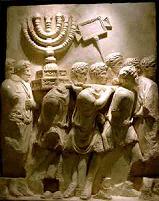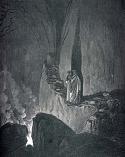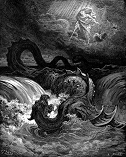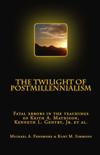Simmons Second Response to Frost
I. First Resurrection
At issue in this section is the meaning of the “first resurrection” of Rev. 20:4-6. Simmons maintains that the natural emphasis of this section is upon the martyrs reigning with Christ in Paradise. These martyrs are those who have given their lives in testimony under the persecution of Nero Caesar. That they have died under Nero is seen by the specific reference to the beast and the mark or number of his name, which in Hebrew letters equals six hundred three score and six. (Rev. 13:18) They have been faithful unto death and have won the crown of life and are sit down with Christ in his throne (Rev. 2:10; 3:21) where they await a second, “general” resurrection. The living saints on this side of eternity shared in this reign, having been “raised up together and made to sit together in heavenly places” (Paradise) in Christ Jesus with the martyrs and deceased saints. (Eph. 2:6; cf. Col. 1:13) However, this “raising up” of the living saints is merely a “legal fiction.” They are not actually or spatially in Paradise, they are merely considered to be joined with the deceased saints in contemplation of law, having been raised up by death, burial, and resurrection with Christ through baptism. (Rom. 6:3-6; Col. 2:11, 12; Heb. 12:22, 23) Notwithstanding that the living dwelt in Paradise and therefore were partakers of the first resurrection in contemplation of law, the emphasis remains upon the martyrs. They are called souls, they have been beheaded, they have undergone a resurrection of sorts, and now live in a realm where life lasts a thousand years. The longest any man ever lived was 969 years. (Gen. 5:27) A thousand years thus exceeds the life of any man upon earth and shows that their reign is “other worldly.”
Against this interpretation Frost offers three arguments: 1) The beast is not a reference to Nero, but to any of the emperors or even Jerusalem; 2) there is only one death and one resurrection that redemptive history speaks to 3) the first resurrection speaks to regeneration and an interim thousand-year reign of Christ.
Frost’s mark of the beast argument is without merit. Frost says the Jews received the mark of the beast under Tiberius by saying they had no king but Caesar (“She took the ‘mark’ of the beast by proclaiming under Tiberius, ‘we have no king, but Caesar.’ That is to take the mark”). There is no exegetical basis for this conclusion in the book of Revelation or anywhere else in the Bible. The “mark of the beast” is not mentioned in the gospels where they Jews made the said remark; it is mentioned only in Revelation; Revelation, not the gospels, defines what the “mark of the beast” means and it is clearly associated with Nero, whose name is the number of the beast. The fact that Daniel calls the nations of his visions “beasts” is equally unavailing, for it is with Revelation we have to do, not Daniel, who does not even mention the mark of the beast. Frost’s beast-equals-emperor argument may thus be dismissed.
Frost says there is only one death and resurrection that redemption is concerned with: “Dead is dead, and in Adam, all men were born dead, and it is THIS DEATH that Christ destroyed…There is only ONE resurrection (the Bible never speaks of ‘resurrections’)…To radically separate and create two resurrections is nowhere, then, found in the Bible.” Frost’s mistake here is that the Bible speaks of at least five different types of death. For example, there is physical death, moral and spiritual death, there is judicial death, then there is civil death, and finally, there is eternal death. Not to mention national death of Israel while in captivity. (Ezek. 37:1-14) Civil death occurs in contemplation of law when a man and woman were divorced. By a bill of divorce a man died in contemplation of law to his former wife so she could remarry without being an adulteress. (Cf. Rom. 7:1-3; Deut. 24:1, 2) Moral and spiritual death occurred when mankind came under the power of sin through the transgression of our first ancestor. Judicial death speaks to the judgment of law pronounced against man for his own transgressions. “The wages of sin is death.” (Rom. 6:23) It is to this death that Ephesians refers when it says “And you hath he quickened who were dead in trespasses and sins.” (Eph. 2:1) It is not moral or spiritual death he here speaks of, for moral and spiritual rectitude cannot free man from the law’s judgment of death for his sins. Finally, eternal death (the “second death”) speaks to the destruction of the lost in Gehenna.
Obviously, not all of these "deaths" are the object of the eschatological resurrection. Even so, with so many “deaths” spoken of or alluded to by the scripture, is it unreasonable that there should be more than one “resurrection?” Contrary to Frost’s assertion, Jesus did not come merely to destroy spiritual death; he also came to deliver man from judicial and eternal death. If a man is made morally and spiritually alive by repentance, he is made judicially alive by justification in Christ. Rebirth is not merely moral and spiritual it is also ceremonial; man must be born of both water and the Spirit, he must believe and be baptized. (Matt. 18:3; Mk. 16:15, 16; Jno. 3:3-6) The souls in Paradise who were martyred under the beast were members of the “first resurrection,” but looked to the general resurrection on the last day when they would inherit heaven. Thus, here are two resurrections. Frost claims it is “false” to hold that “‘resurrection from the dead’ means resurrection from Hades.” But if coming out of Hades is not a resurrection, what is it? Jesus was raised from Hades (Acts 2:27), Rev. 20: 13 says “death and hell (Hades) delivered up the dead which were in them,” I Cor. 15:55 says “where oh Hades is thy victory?” Thus, resurrection from the dead most emphatically did speak to resurrection from Hades. Frost’s assertion that there is only “one resurrection” and this exclusive of Hades is totally without merit.
Frost mentions an argument of King as being “devastating.” Here it is:
“In the passage in John 5, the dead hear the voice of the son of God and ‘live.’ Then Jesus states that the time is coming ‘when all who are in their graves will hear his voice and come out’ and be judged according to their deeds (which occurs at the ending of the millennium, Rev 20.15-ff). King raised an objection here that is, in my opinion, devastating: If the dead who were hearing the voice of Christ were then ‘coming to life’ and eventually physically died, then would they, now in their graves, come to life AGAIN? That is TWO resurrections for one believer! Thus, the ‘first resurrection’ pictured in John 5.25 is mere fiction, whereas the ‘actual and spatial’ resurrection is 5.28. However, since the ‘dead’ in verse 25 have already ‘come to life,’ then they physically die, they will again be raised ‘from the tombs’ in the real resurrection. Does any of this make sense?”
This argument is truly superficial. If it is devastating, it is only to the position of Frost and King. If a first century Jew or Gentile heard the word of the gospel and thus came to “life,” but subsequently died before A.D. 70 and the general resurrection, Yes, of course he would experience two resurrections! The first when he entered spiritual life through conversion, the second when he was taken from Paradise and entered eternal life in heaven. Today, those coming to Christ still receive two resurrections: The first when they are justified from sin when they obey the gospel and are baptized, the second when the outer-man perishes and “faith is made sight.” It is true that we are soteriologically restored to the presence of God before the throne when we are washed from our sins, but actually and spatially we remain separated from God by the veil of the flesh and our sinful nature. Paul refers to this when he says, “Whilst we are at home in the body we are absent from the Lord…We are confident, I say, and willing rather to be absent from the body, and to be present with the Lord.” (II Cor. 5:6, 8) The simple fact of the matter is that putting off the body of flesh and receiving a spiritual body fitted for the ethereal realms above is a resurrection, whether Frost will admit it not.
Frost is at pains to shift the focus of Rev. 20:4-6 from the martyrs in Paradise to the regeneration of the saints on earth and an interim thousand year reign of Christ. Frost says, “The thousand years are the time allotted of the Messianic reign of Jesus over Israel on David’s throne crushing his enemies and putting them over his feet, with the saints raised with him fighting the heavenly powers of the Dragon, the Death, the Sin and the like.” I am sure that is all very nice, but where is any of this in the Bible? Where does the Bible – Old Testament or New – ever speak about a thousand year reign of Christ? Not one verse of scripture can be brought forward in support of this notion. It is Postmillennialism plain and simple and all the objections against Postmillennialism (and there are many) apply against King’s and Frost’s scheme. Jesus has only one eternal reign, the Bible never breaks it up into little segments. Yes, he had to put all enemies beneath his feet, but the Bible nowhere speaks of this process as belonging to any sort of “interim, thousand-year reign.” The dragon was bound a thousand years and the saints and martyrs reigned in Paradise a thousand years. Not one word about Christ reigning a thousand years. Not one.
Frost makes much of the fact that John calls the saints on this side of eternity “kings and priests,” implying thereby that they were already reigning. However, this seems to be plainly mistaken. John’s use of the terms kings and priests is used in anticipation of the great consummation and is an example of the “already-but-not-yet” nature of the transition period in which things in expectation are spoken of as it already possessed. The saints reigned in Paradise with the martyrs (Eph. 2:6; Rev. 20:4), but they would reign upon earth (the new earth) in the regeneration; it is to this that John alludes. This is why the twenty-four elders proclaim “Thou hast made us kings and priests and we shall reign on the earth.” (Rev. 5:10) “Shall reign” points to a future condition, not a present one. Paul makes the like statement to Timothy: “If we be dead with him, we shall also live with him: if we suffer, we shall also reign with him.” (II Tim. 2:11, 12) Paul alludes to this eschatological reign in his first letter to the Corinthians, saying, “Now ye are full, now ye are rich, ye have reigned as kings without us: and I would to God ye did reign, that we also might reign with you.” (I Cor. 4:8; cf. Matt. 19:28) In other words, the Corinthians are already tasting the powers of the age to come (Heb. 6:5) and Paul wishes that the consummation were already accomplished that he and his associates might reign too. Let us not be mistaken in this, we affirm that the saints shared in the reign of the martyrs depicted in Rev. 20:4-6. However, this reign is in Paradise, not upon earth. Frost and King want to shift this reign to earth after the manner of Millenarianists and it is here that they wander from the truth.
II. Frost’s Early Resurrection Theory
Frost has no explanation for why his one millennium has two different endings. According to King and Frost, the thousand year binding of the dragon ends in A.D. 66 at the Jewish revolt from Rome but the thousand year reign of the martyrs ends in A.D. 70 at the consummation. Thus, they have the insurmountable problem of two one thousand year periods that end at different times and events. But never mind, there is only a single one thousand years between them! To avoid this flaw in their theory, Frost now invents a totally new approach – The resurrection actually occurred in A.D. 66! Thus, if your theory doesn’t match the facts, just make up new facts! Frost realizes the weakness of his argument and fully expects Preterists to reject it. Let us go over it briefly.
Frost’s argument boils down to “white-robes-equals-resurrection-equals-little-season-the-dragon-was-loosed.” (“The robes are washed and made completely white through the tribulation period, or little season. The souls are given white robes and told to wait for a little season. At the destruction of the City, the Bride is adorned with white robes. If being given white robes corresponds with resurrection, which I think it most certainly does, then we can say that the final cleansing of resurrection-transition for all was in that final ‘little season.’”) Unfortunately Mr. Frost argues from false premises to wrong conclusions. First, not one word of scripture can be marshaled showing that white robes correspond with the eschatological resurrection when the souls of those in Paradise were taken to heaven. To the contrary, white robes are possessed by the saints from and after their obedience to the gospel. They are a token of approval by God and are given to those who pass the test of any trial or tribulation wherein they are called to be faithful. Thus, Christ says to the church of Sardis that “he that overcometh, the same shall be clothed in white raiment.” Concerning the great multitude which came through the great tribulation, John is told “These are they which came out of great tribulation, and have washed their robes, and made them white in the blood of the Lamb.” (Rev. 7:14) The book of Daniel states “Many shall be purified, and made white, and tried; but the wicked shall do wickedly: and none of the wicked shall understand; but the wise shall understand.” (Dan. 12:10) Notice that in all these verses white robes are joined to faithfulness under testing, not resurrection. Put a circle upon paper and write in it all the verses that equate white robes with the eschatological resurrection and at the end of the day that circle will still be empty. The verses just don’t exist. Frost’s argument is as empty as the circle.
Secondly, Frost’s argument would make the wedding and resurrection simultaneous with the destruction of Jerusalem. However, the scriptures are clear that the king sent forth his armies, destroyed the murderers, and burned up their city, then the wedding was ready. (Matt. 22:1-8) Revelation confirms this; the wedding of the bride there follows the destruction of the harlot. (Rev. 18, 19:7) The unfaithful wife must first be put away and suffer execution before a new wife is taken.
Finally, Rev. 15:8 seems decisive on the matter when it states that no one was able to enter the temple in heaven till the plagues of the seven angels were fulfilled. In other words, it was not until after the wrath of God was spent upon Jerusalem that the resurrection occurred. With this agrees Hebrews, which states that the way into the holiest of all was not manifest while the first tabernacle was yet standing. (Heb. 9:8) It is common knowledge that the judgment and resurrection were at the “last day” (Jno. 11:24; 12:48), not the “little season.” The last enemy was death (I Cor. 15:26), not the Jews. Christ would put his enemies beneath his feet, beginning with the Jews and ending with death. Frost’s argument ignores this well established chronology of scripture.
Each of these and other points might be developed further, but I think the picture is clear. Frost’s new theory cannot be squared with the facts and may be dismissed out of hand.
III. Frost’s Adoption of King’s Vicarious Redemption
Frost alleges that I misrepresent King by claiming he teaches a vicarious redemption. But my reading of Frost’s defense only confirms what we have been saying: King and Frost teach that the Old Testament saints were saved through the response of the New Testament Jews. There was an “organic bond” between them that meant that the Old Testament saints were saved if, and only if, New Testament Jews obeyed the gospel.
Here is King’s statement, let the reader decide what King means: “Were it not for the response of the baptized remnant or firstfruit Jews, Israel would have been left to perish.” King himself even calls it vicarious redemption: “This is clearly a case of vicarious or representative redemption… From this there is no escape.” Sounds pretty simple to me! If King did not mean vicarious redemption, why did he call it such?
I can discern no difference between King’s vicarious redemption and Frost’s. Hear Frost now: “The ONLY WAY Israel could be redeemed is through the body of Christ… Therefore, they were made MEMBERS of that body through Spirit’s applying of blessings upon the firstfruits so that through the part, the whole could also be included.” Did you catch that? The Old Testament saints were made members of the body of Christ through the firstfruits; through the obedience of the gospel Jews, the Old Testament saints were included in the blessings of Christ! Poor Sam, this is not Reformed theology at all! The logical corollary is that if no Jew obeyed the gospel, the Old Testament saints would have perished, as alleged by King. Hear Frost again: “Thus, if the firstfruits obtained what Israel so earnestly sought for, and the whole is holy because of the firstfruits, then those being baptized ‘on behalf of the dead’ are clearly, organically connected to the dead whose behalf they were being baptized for.” Thus, according to Frost, the whole (Old Testament dead) are holy because of the firstfruits (the gospel Jews). Thus, when Jews obeyed the gospel the “organic bond” (where is this ever mentioned or taught in the Bible?) between them and their dead ancestors meant that the dead were vicariously redeemed by the living; they were mysteriously removed from the “dead” and added to “living,” they became members of the body of Christ by the response of gospel Jews and in this way, and only this way, came in contact with the saving blood of Christ. The reader will immediately recognize that the Bible nowhere teaches such a ridiculous notion. This is nothing if not a wedding of Catholic purgatory and Mormon baptism for the dead. If Frost cares to take it up further, we can debate it formally in writing. But rather than debate Frost about what King means, King could clear this matter up by simply explaining himself, and disallowing this doctrine. There is an old saying that says “He who is silent consents.” King’s silence is evidence that I have not misrepresented him one wit. But then don’t rely upon me, read his book yourself!
Concluding Remarks
Frost and King are beloved brothers. Unfortunately, Frost has come under the influence of King and has adopted King’s false doctrine of firstfruits. According to this doctrine, were it not for the response of the baptized remnant or firstfruit Jews, the Old Testament saints would have been left to perish. Frost doesn’t like the term “vicarious redemption,” but call it what you will, either way it is unscriptural. King has expressly stated that there are “two one thousand years terms.” Thus Simmons is not the only one who has seen two millennia in Rev. 20:4-6. This grieves Mr. Frost who insists only one millennium is contemplated by the text. However, when his theory is shot full of holes by the fact that the loosing of the dragon at the end of its thousand-year binding doesn’t correspond to the resurrection of the saints at the end of their thousand years, he simply invents a new theory for the timing of the resurrection! Although he fully expects it to be rejected by Preterists, he says it is the only way he can save his single millennium model. (“I offer it humbly in full anticipation of disagreement and rejection, but, as of now, I can see no other solution.”) Frost has thus committed himself to a position that he cannot defend. We hope that thinking students of the Bible will not follow in his mistake.
To receive Kurt Simmons’ e-mail newsletter, The Sword & The Plow, click the Subscribe link:
All rights reserved.






